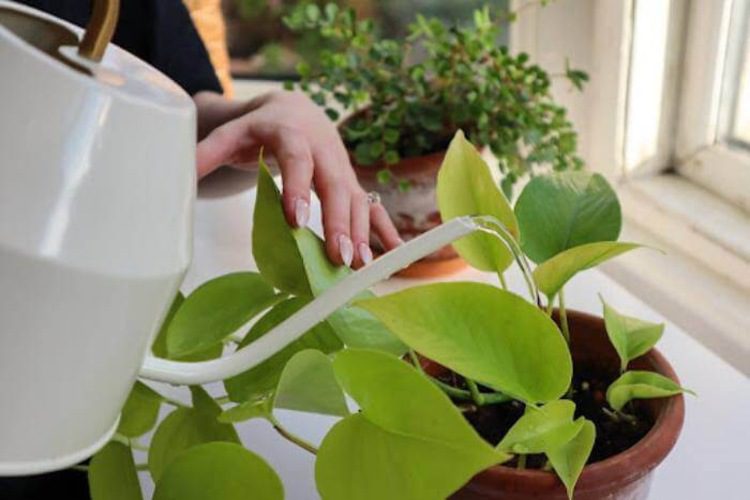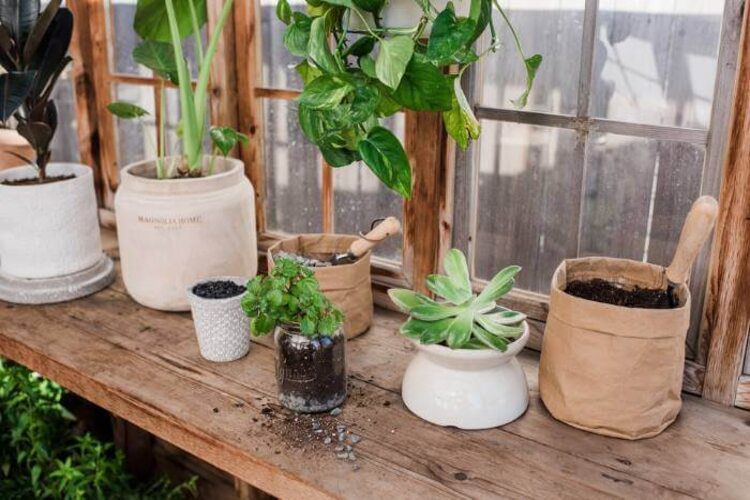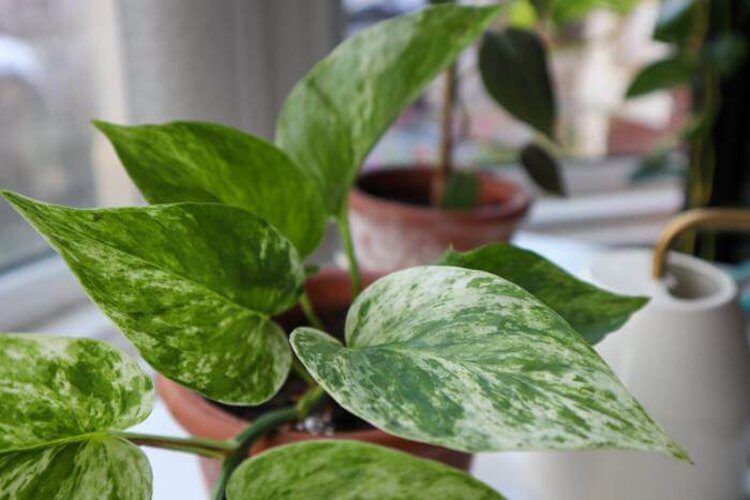Snow Queen Pothos Care: The Indoor Plant Growing Guide

The hardy Snow Queen Pothos plant has made it onto many people’s lists as one of the best indoor plants for homes. These beauties are low-maintenance and basic-care demanding, which makes them perfect additions to any space. In this article, we take a look at how best to plant and care for Snow Queen Pothos indoors as well as outside.
| Scientific Name | Epipremnum Aureum (Snow Queen) |
| Common Name | Snow Queen Pothos |
| Family | Araceae |
| Origin | Asia |
| Plant Type | Evergreen house plant |
| Bloom Time | Spring, summer |
| Flower Color | Green, white |
| Soil | Moist but well-draining |
| Water | Not too wet |
| Temperature | 65 to 85°F |
| Sunlight | Partial |
| Toxicity | Cats, dogs and children |
About Snow Queen Pothos
The Snow Queen Pothos is a versatile tropical houseplant that can grow tall and thick enough to display in hanging baskets or planters. It’s most commonly grown as a houseplant. If you live in an area where frost occurs during the winter, this lush green curiosity may not work for your needs because it will die without protection from freezing temperatures.
Snow Queen has a stunning appearance, as the name suggests, with predominant white splotches variegated with less-light green streaks. The many different colors of the leaves are enough to make your eyes spin. You can find green, speckled chartreuse, or even a marbled cream and green variety, which makes it easy to be mistaken for Marble queen Pothos.
When you are looking around the room, these plants are worth noticing. They’re vining eloquently through ceiling rafters and hanging planters with their delicate-looking leaves that give off an otherworldly vibe as if they were part of plant life from another dimension. This variety is one of the lowest-maintenance members of its group, being compact and less fertile than other Pothos varieties.
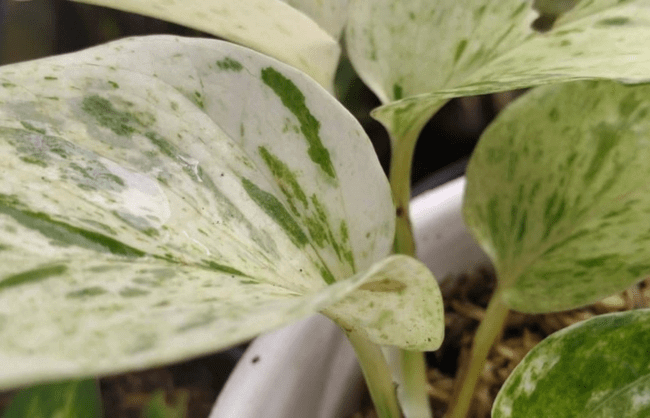
Snow Queen Pothos Care
Light
Pothos does well in medium-to-low light conditions. If this plant does not receive enough light, the white variegation will bleach and eventually fade. The delicate leaves can be burned by direct sunlight.
If you keep them as houseplants, place them in a location where they will receive natural sunlight for at least 4 hours per day. If you are using them as office plants, place them near a window where they will receive indirect sunlight during the day.
Similar to Snow Queen Pothos, Manjula and N’Joy Pothos also do well in medium-to-low light conditions. However, they can tolerate lower light conditions than Snow Queen Pothos.
Soil
Make sure that the soil is rich in organic matter like living organisms, crop residues, decomposing matter, humus, etc. These natural materials help improve the soil’s physical, chemical, and biological functions.
Snow Queen Pothos requires soil that is moist but well-draining. To avoid compacting the roots, create an airy potting mix. You can make your own combination of orchid bark, perlite, and potting soil or purchase a pre-made mix from your local garden center.
Watering
Overwatering is one of the leading causes of plant death, so allow the soil to dry through the top 1-3″ before watering again. It is best to use well-draining soil, pots with drainage holes, and moderate amounts of water. In the winter, cut back on watering to help your plants survive.
Manjula and N’Joy Pothos are also susceptible to overwatering. It is important to water them when the top 2-3 inches of soil are dry.
Fertilizer
Fertilize your Snow Queen Pothos once every two weeks during the growing season (spring and summer). Use a balanced liquid fertilizer diluted to half-strength. You can also provide some slow-release options, like top dressing with vermicompost or foliar feeding with seaweed fertilizer.
Pruning
Although pruning is not necessary for pothos care because of its slow growth. You can prune your Snow Queen, and their other Pothos such as Manjula, N’Joy, and Pearls and Jade Pothos, whenever you like to keep them looking their best. To encourage new growth, cut the stems back by about one-third of their length. Be sure to use sharp, clean shears or scissors to avoid damaging the plant.
Temperature
Snow Queen Pothos plants like a temperature range of 65 to 75 degrees Fahrenheit. They can tolerate lower temperatures, but may not grow as well. Higher temperatures can also be tolerated, but the leaves may start to turn yellow.
Humidity
Pothos plants, like all tropical and subtropical forest trees, thrive in the mid-humid conditions that they prefer. They need to be kept at 50–75%.
In the home, you can provide humidity by placing the plant on a tray of wet pebbles and keeping it in a room with high humidity, such as the bathroom or kitchen. You can also mist the leaves of the plant regularly.
Repotting
In order to keep your Snow Queen Pothos healthy, you should always make sure that the pot has enough drainage holes in it. Pothos is one of those plants that likes to be root-bound, so you don’t need frequent reports. When the roots have completely filled up your pot, it’s time to repot. This will allow more soil nutrients and oxygen into each root system so they can grow well.
To repot your Pothos, start by gently removing the plant from its current pot. If the roots are very tangled, you may need to use a sharp knife or scissors to cut them free. Next, spread out the roots in the new pot and fill in around them with fresh potting soil. Make sure to water the plant well after repotting.
Snow Queen Pothos Propagation
Like most plants, the Snow Queen’s propagation is straightforward. Simply take stem cuttings from your plant and place them in water for about two weeks before putting them into the soil compound to make sure they are well rooted. Propagate your pothos like the pros with these easy-to-follow steps:
Cutting Preparation
When taking cuttings, use sharp scissors or pruning shears to make a clean cut just below a node (the place where a leaf meets the stem). Remove all but the top two leaves from the cutting and discard any buds or flowers. If you are rooting your cuttings in water, dip them into a rooting hormone powder before planting.
Rooting in Water
Place them in a glass or jar filled with lukewarm water and cover them with plastic wrap to hold in the moisture. Change the water every day, and keep an eye on the roots as they grow. When they are about 1 inch long, transplant them into pots filled with potting mix.
Rooting in Soil
If you are rooting your cuttings in soil, fill small pots or trays with moist potting mix and make a small hole in the center of each pot.
Dip the cut end of the cutting into rooting hormone powder, then insert it into the hole in the potting soil. Gently firm the mix around the base of the cut. Water well and place in a warm, humid spot out of direct sunlight. Keep the soil moist but not soggy.
Caring for Your Propagated Plants
Once your cuttings have rooted and begun to grow, give them a little fertilizer to help them along. Transplant them into larger pots when necessary, and keep them in a bright spot out of direct sunlight. Pothos are not fussy plants, but they do prefer warm temperatures and high humidity. If the air in your home is dry, mist the leaves of your plants regularly.
Pothos are fast-growing plants, so you will need to prune them regularly to keep them under control. Prune back stems that have become too long and cut off any yellow or dead leaves. With proper care, your Snow Queen Pothos will thrive and provide you with years of enjoyment.

Toxicity
The Snow Queen is a popular indoor plant that is known for its beautiful leaves. However, this plant can be toxic to pets if ingested.
Pets that have eaten parts of this plant may experience vomiting, diarrhoea, and even seizures. Be sure to get in touch with your veterinarian immediately if you believe your pet has ingested this plant.
Common Problems
Yellow leaves
One common problem with Snow Queen is that the leaves can turn yellow. This is often a sign of overwatering, so be sure to water only when the top inch of soil is dry to the touch. You may also want to reduce the amount of fertilizer you’re using, as too much can also cause the leaf to turn yellow.
Brown leaves
Another common problem with this plant is that the leaves can turn brown. This can be caused by several things, such as overwatering, underwatering, low humidity, or direct sunlight. If your Snow Queen Pothos’s leaves are turning brown, try to determine the cause and correct it.
Not growing
If your Snow Queen Pothos isn’t growing, there are a few things you can do to try and fix the problem.
First, make sure that your plant is getting enough light. This plant needs at least six hours of indirect sunlight per day to grow properly. If it’s not getting enough light, move it to a sunny spot or use a grow light. Second, make sure that your plant is getting the right amount of water. The pothos like moist soil but not wet soil. Water thoroughly when the top of the soil feels dry to the touch.
If you’re still having problems getting your plant to grow, try adding a little bit of fertilizer to the soil. A balanced fertilizer like 10-10-10 will work best.
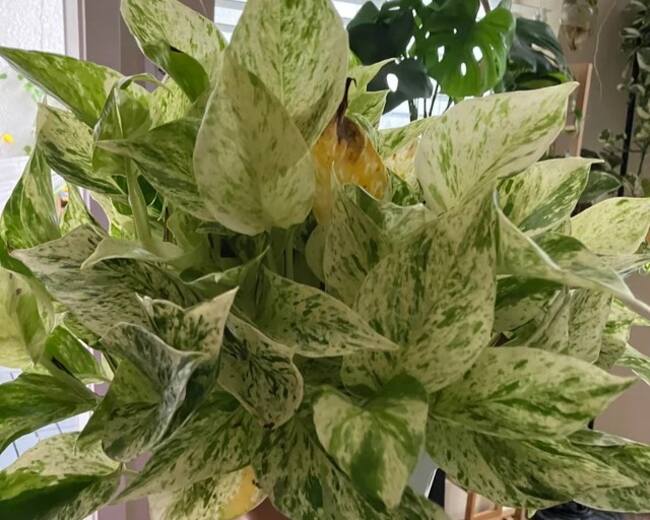
Care Tips
Snow Queen Pothos is a beautiful, trailing plant that can be grown indoors. Here are some tips for keeping your Snow Queen looking its best.
- Keep the soil moist but not wet.
- Fertilize every other week with a liquid fertilizer diluted to half strength.
- Prune regularly to keep the plant bushy and compact.
- Be sure to provide plenty of indirect light; too much direct sunlight will scorch the leaves.
- While there are a few pests that would love to suck the sap from your pothos, they’re not in large numbers, and keen observation is important if you want to prevent their establishment.
Conclusion
The Snow Queen Pothos is a perfect houseplant for those who enjoy versatile and attractive plants. It can be grown in hanging containers or as an upright architectural delight, making it easy to find room on your desk!
FAQs






